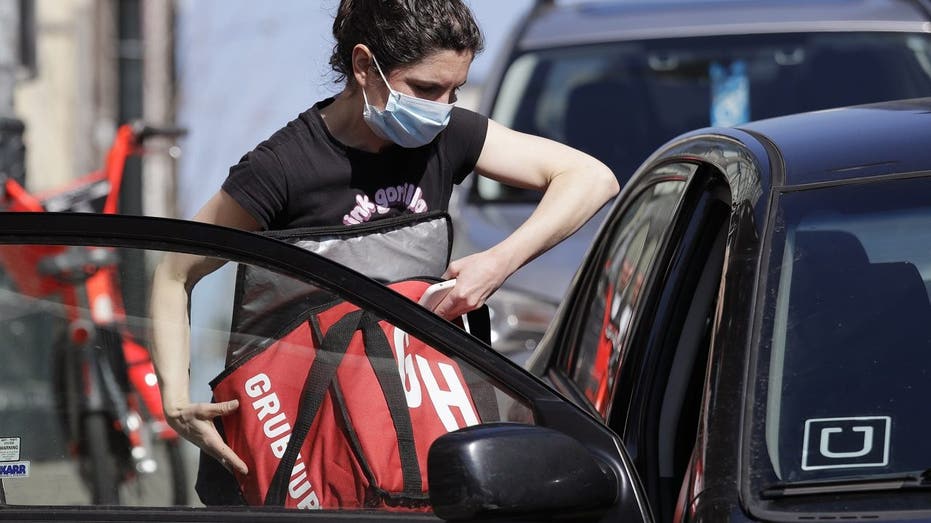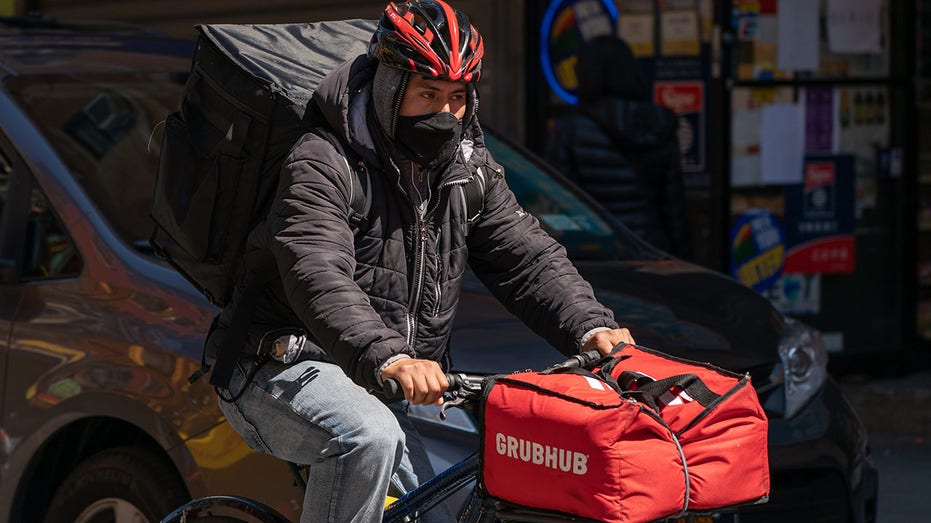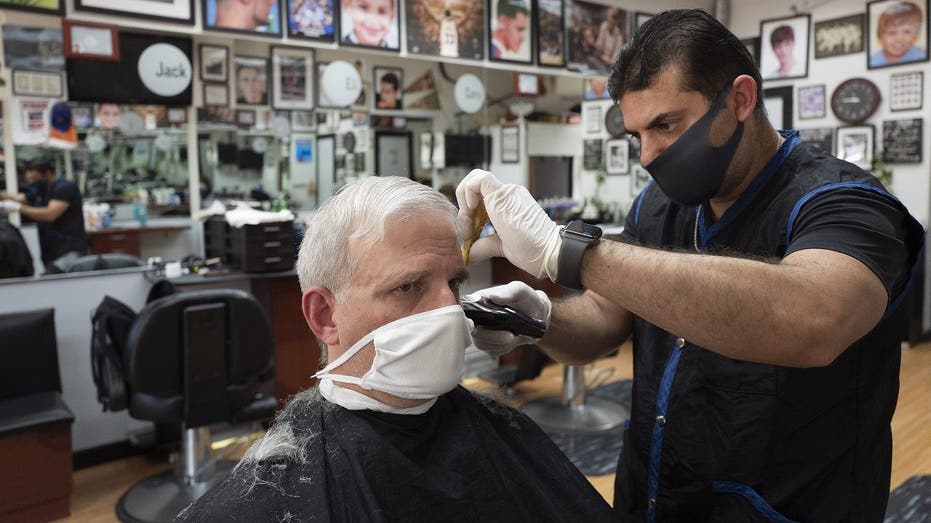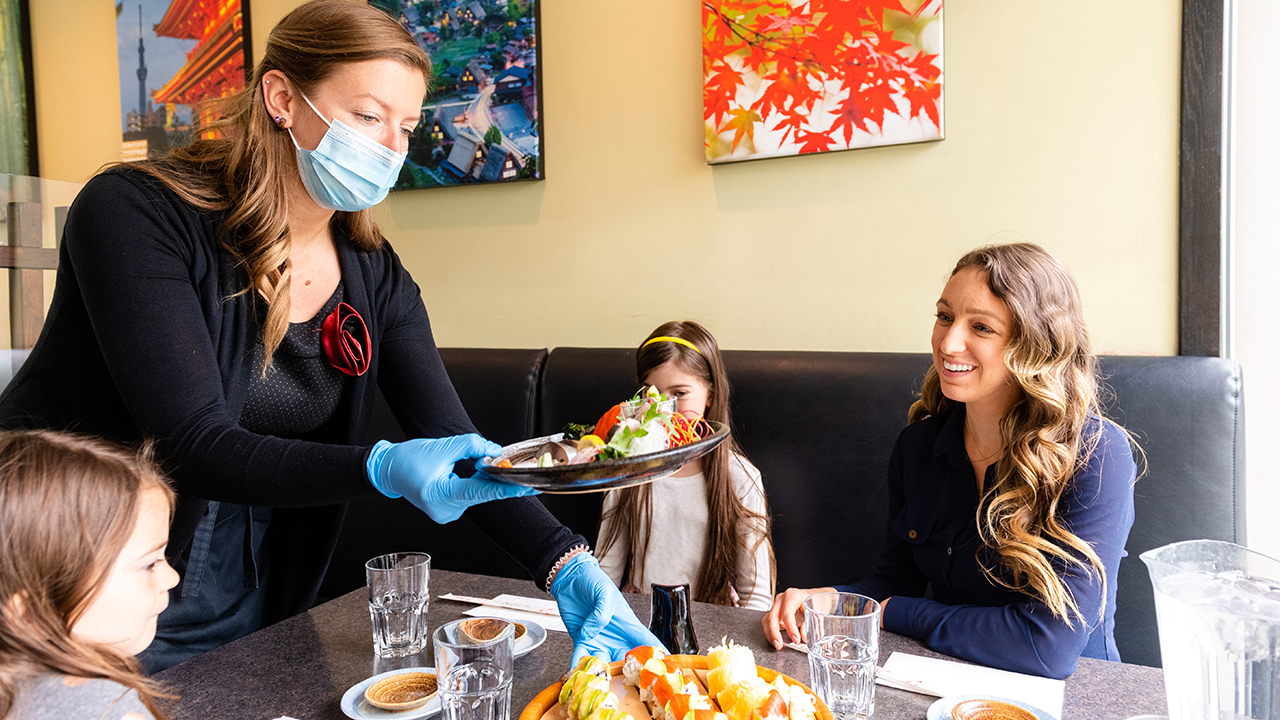Driving over air travel, takeout over cafes: Pandemic shapes consumption
Coronavirus has consumers spending differently
U.S. consumers are buying again, but their shopping patterns show broad fears of persistent health risks amid the pandemic.
Coronavirus cases, after reaching a plateau in April and May, are rising across the South and West, sparking fears of a resurgence. The data show consumers have in many ways been mindful of the risks all along, consistently shunning hotels and air travel and spending on driving and Airbnb bookings.
Spending data reflect recent reopenings, with consumers cutting back on some online grocery purchases and flocking to hair salons and furniture stores. But they also spent on takeout and food delivery, and continued to splurge on home improvement and sporting goods.

Food delivery driver Dori McGuire Guy wears a protective mask as she loads a take-out order into her car at the Pike Place Market, Friday, March 20, 2020, in Seattle. (AP Photo/Elaine Thompson)
These patterns are important. Consumer spending is a critical engine of recovery, typically driving two-thirds of U.S. output. Economists say the data show that, despite calls to reopen and ease shutdown orders -- and despite a spirited national debate over mitigation measures such as face coverings -- consumer habits reflect continued social distancing amid fears the pandemic won't be ending soon.
"Infection concerns drive the overall level of business activity far more than any specific policy," said Chad Syverson, a University of Chicago economist whose recent study found that around 90% of the decline in economic activity stemmed from voluntary avoidance of commercial centers.
Getting Away From It All

Close-up of a woman using the Airbnb app (iStock)
STOCKS SET TO BOUND HIGHER DESPITE COVID-19 OVERSHADOWING BREAKOUT QUARTER
Plane trips and hotels were out, and road trips to bungalow rentals were in. Consumers spent 6% more on Airbnb and HomeAway bookings in June than they did before the pandemic took hold. But they shied away from high-density areas like airports and hotels.
The getaway theme also turns up in state-level data. Vermont's grocer sales, for example, have grown at twice the rate of the rest of the country, because 25% of the sales are to out-of-town visitors -- "way higher than last year," said Michael Maloof, associate director at Earnest Research, who says the growth is likely vacationers and remote workers stocking up for holiday rentals. "Folks staying in hotels don't usually go out for groceries," he said.
Renovation Nation

Kathy Lihue and Mike Green sit in a Lowe's home improvement store as they shop for outdoor furniture March 22 in Los Angeles. They said that they are searching for outdoor furniture because they planned on being at home for the most part. (AP Photo/M
TRUMP EXTENDS PPP DEADLINE WITH $130B LEFT IN SMALL BUSINESS FUND
Consumers are still nesting. Home-improvement spending eased somewhat but was up 40% in the week ended June 24 from the same period last year, according to Earnest Research. "Even as people venture out, we are still living a more stay-at-home lifestyle," said Marshal Cohen, chief analyst at the NPD Group Inc., a market-information and advisory-services firm.
Consumers are shelling out on furniture. In the week ended June 24, sales were 28% higher than the same week in 2019, according to Earnest Research. Online orders surged in mid-April, around the time that consumers began receiving stimulus checks, noted Mr. Maloof. However, by mid-June, sales at bricks-and-mortar furniture stores returned to pre-pandemic levels.
Venturing Out
Pent-up demand for outdoor leisure drove sales in sporting goods as states reopened beaches and parks, with sales up 48% nationwide by the week ended June 24, after collapsing by half in early April. Shoppers in places that reopened first have powered the sporting-goods recovery.
Drinking at Home

Joe Snooks stocks up on beer and liquor on March 23, 2020 in Denver, Colorado. (Photo by Michael Ciaglo/Getty Images)
GOVERNOR WARNS CALIFORNIA OFFICIALS TO ENFORCE HEALTH RULES
States reopened bars and restaurants throughout May and June, but a lot of people didn't respond. Wine and liquor store purchases show consumers continuing to drink at home, with sales still rising at rates in the high double-digits as of June 24.
These patterns may not shift soon, according to a survey by Drizly, an online alcohol marketplace that connects buyers with local merchants. Roughly 44% of respondents said they had no plans to return to bars soon, or would do so when a coronavirus vaccine became available, compared with around 16% who said they'd already returned or would do so once venues reopened.
"Not all consumers are ready to go out like they did before," said Liz Paquette, Drizly's head of consumer insights, noting that 70% of respondents said they planned to drink at bars and restaurants less frequently than before the pandemic. However, that impulse varied by location, with Houstonians embracing at-home tippling at a higher rate than Angelenos.
Eating Out (but Still Dining In)

A food delivery courier for Grubhub Inc. wears a protective mask in New York, U.S., on Monday, April 6, 2020. (Jeenah Moon/Bloomberg via Getty Images) (Getty Images)
The online grocery boom that began in late March eased over the last month -- but not necessarily because consumers were flocking to restaurants.
"People are still spending a lot on grocery delivery but they are starting to get sick of cooking at home," said Robert Frick, corporate economist at Navy Federal Credit Union, pointing to the continuing strength of delivery services like Grubhub, DoorDash, UberEats, and Goldbelly.
Haircuts Rebound, Then Ease Again

Howard Kaplan gets a haircut from Eli Gilkarov at Jack's Barbershop, Tuesday, June 9, 2020, in Larchmont, N.Y. (AP Photo/Mark Lennihan)
US CORONAVIRUS CASES HIT SINGLE-DAY HIGH AHEAD OF JULY 4 WEEKEND
Hair salon sales leapt sharply after local authorities allowed those businesses to reopen, according to data from Facteus, a firm that tracks credit-card transactions. Florida hair salon sales picked up after most counties reopened on May 11 -- and even more when Miami-Dade and Broward counties eased restrictions on May 18.
And yet, in many states that reopened hair salons in May -- for example, Georgia, Texas and Ohio -- consumer numbers have yet to recover to March 1 levels. Growth in the number of salon customers in Massachusetts, which suffered one of the nation's severest outbreaks, plateaued at around half of those levels.
The length of the lockdown helps drive the bounceback. In Georgia, where customer numbers recovered more gradually, hair salons were shut down for just three weeks, compared with 12 weeks for Michigan hair salons.
The limited recovery may result from restrictions on customer numbers to preserve social distancing. Data from Homebase, which provides scheduling and time management software for 60,000 small businesses, shows a slowing of growth in salon reopenings since May, possibly because operations are crimped by capacity limits and requirements for protective gear for employees.
Shopping... or Joy Riding?

Shoppers wearing face protection ride an escalator at Ingram Park Mall in San Antonio, Friday, May 1, 2020. (AP Photo/Eric Gay) (Associated Press)
GET FOX BUSINESS ON THE GO BY CLICKING HERE
As lockdowns began lifting in late April, consumers seized the chance to spend at newly reopened enterprises. Consumers in Louisiana and Washington state thronged casinos in May, while Missourians upped their visits to optometrists and Kansans headed to hobby and toy stores, according to SafeGraph, a data company with foot-traffic data for five million locations in the U.S.
Yet, as of late June, foot traffic to businesses across the U.S. was still down 19% from March 1 levels, though the recovery in consumer activity varied by state.
Foot-traffic data reveal that people are getting out -- but not necessarily to shop. Gas stations were among the first places people returned to: As of June 21, visits to gas stations nationwide were nearly one-fifth higher than March 1 levels.
But trips to malls remained 8% lower, while car-dealership activity was down more than 10%, hinting that some consumers may be wary of retail that requires more human interaction than pumping gas.
Dressing Down
Clothes spending rebounded faster in states that reopened in late April and early May, down only around 5% in those places, versus the previous year -- compared with a 23% decline in sales in the rest of the U.S., according to Earnest Research.
However, in-person spending powered little of that recovery. In fact, online clothing sales are rising faster in states that had limited or brief shutdowns than in places with the severest lockdowns.
READ MORE ON FOX BUSINESS BY CLICKING HERE
